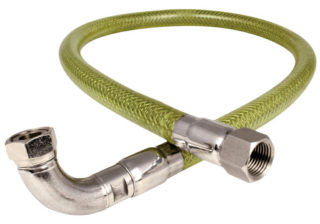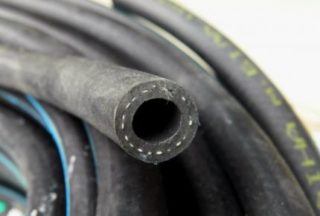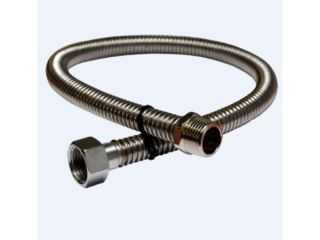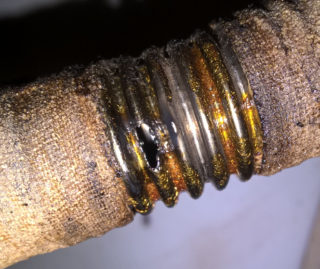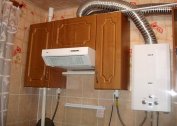Cookers or gas water heaters for a long time were connected to the central highway using steel pipes. Today there are adapters made of other materials. The gas hose must meet safety requirements, so before making a choice, you need to consider the characteristics of different types of products.
Varieties of gas hoses
Gas connections are bellows, reinforced, made of fabric and rubber. All of them differ in duration and operating conditions, technical characteristics. The choice depends on the specific situation.
Rubber fabric hose
Households are often made from rubber and fabric. This type of product is cheap and simple. The sleeve is soft, flexible, but reinforced with textile thread. The device is used at temperatures from -10 to +50 degrees. In installation and use, the hose is unpretentious. However, the rubber after some time begins to harden and crack, which is fraught with leakage of gas.
To increase the service life of the product, elastic components are introduced into the rubber composition. The advantage of flexible gas hoses is considered to be good elasticity and non-conductivity of electricity. They are quickly mounted, you can choose devices of different sizes and diameters.
However, there are some disadvantages:
- instability to mechanical influences;
- insufficient level of rigidity;
- little protection against temperature extremes.
The use of rubber hoses is not recommended, as they are subject to natural wear and tear. If the product is connected, then not to the main pipe, but to the cylinder. It should be changed every 2 years. There are no special fasteners at the ends of the product, so they simply put it on the outlet fitting. For fixing, metal clamps are used. If there are mounts, installation requires paronite gaskets.
Rubber Reinforced Hose
For the manufacture of a gas hose, vulcanized rubber reinforced with a yellow steel braid is often used. The inner layer of the tube is composed of polymers. It is a conductor of electricity, and is also able to quickly collapse. This type of product has the following advantages:
- low price;
- ability to withstand temperatures up to 50 degrees;
- wide range of diameters: 12-25 mm and more;
- ease of installation (at the ends of the tube there are fittings and union nuts), ease of operation.
The use of a rubber reinforced hose requires the connection of dielectric inserts. They are screwed between the fixture and the household appliance. The disadvantages include low strength, insufficient level of electrical insulation. This hose must not be used near electrical wires.
Bellows metal hose
The most reliable gas bellows hose is considered. This is a flexible metal element, which contains polymeric materials, stainless steel. The sleeve is tight, able to withstand high pressure, as it is reinforced with wire. It has a sufficient margin of safety and rigidity.
At the ends of the fixture are connecting fittings made of steel and brass. With their help, the hose is connected to the pipe. Products are easily bent, change sizes, while they maintain performance, elasticity and strength. Even with bending, the inner diameter of the tube does not change.Linear expansion and contraction is compensated by the structure of the product.
The reinforced part is protected from the breakdown of the electrical pulse and stray currents. The dielectric insert is mounted at the production stage. The product has the following specifications:
- tube diameter: 12-25 mm and more (on request);
- maximum working pressure: 6 atm;
- length: 30-200 cm.
Installation requires the installation of copper or aluminum gaskets.
Corrugated
Corrugated hose is made of metal. It easily changes shape and length. The initial technical properties do not change even with frequent changes in shape or stretching. Corrugation can be operated in a wide temperature range: from -50 to +250 degrees.
Other
Previously, an oxygen hose was often used to connect household appliances to a gas pipe. It is cheap, durable, copes well with a lot of pressure, even if the rate reaches 20 atm. Now such a product is practically not used. Sometimes it is installed temporarily.
Polyvinyl chloride hoses have the following advantages:
- application without dielectric (the product does not conduct electricity);
- the ability to connect to a cylinder or central line;
- normal functionality at high pressure (up to 0.63 MPa);
- many lengths (up to 5 m);
- high strength, resistance to cracking;
- long term of operation: up to 20 years.
PVC hose is cheaper than gas bellows. The minus is the insignificant stiffness of the material.
Features of choice
For the correct choice of fixture, the type of equipment to be connected is taken into account, its distance from the central pipe, manufacturing material, and recommendations of professionals. Over the entire length from the device to the gas source there should be no intermediate connections, so the length of the hose is initially calculated.
When choosing, the diameter of the section is taken into account. For a good cross of gas, the indicator is 1 cm. For a reliable connection, it is better to choose products with nuts and a fitting.
For home installation
For the effective operation of home equipment, a product 1-2 meters long is required. In this case, the risk of tube rupture is reduced. If the length is insufficient, it is increased with a metal insert. It is better not to use a rubber hose, but if it is installed, carefully monitor the degree of wear. If cracks appear on the product, it is replaced immediately. It is best to install a bellows product.
No need to buy products in which the fitting and corrugation are fixed to each other with glue. Optimally one-piece product. When choosing a hose, you need to consider that there are a large number of fakes on the market.
What gas services recommend
The product should be selected at specialized points of sale where the seller can provide a certificate of quality. Experts recommend purchasing a hose with a margin of length, since it should not be stretched. The following tips will help you make your choice:
- do not buy cheap Chinese-made products, since the wall thickness is small and they are subject to rapid wear;
- a yellow mark should be on the sleeve, which indicates the purpose of the material (plumbing options should not be used);
- when choosing an eyeliner, inspect for cracks or other damage;
- fittings and nuts must match the diameter of the outlet on the appliance.
The length of the hose must be such that it does not sag or stretch.
Signs of a fake
Regardless of the type of gas pipe at the time of purchase, you need to determine that this is not a fake.To avoid choosing a fake, you need to be guided by the following rules:
- Carefully inspect the product. Its walls should be uniform. Do not take options with visible mechanical damage, even if they are minor. Through a minimal crack, gas will leak into the room, which can lead to an explosion or poisoning.
- Compare the real parameters with those indicated in the technical data sheet.
- Carefully consider the quality certificate that the seller must present at the request of the client. It indicates whether the product can be used to work with explosive substances.
- Do not choose products that are too cheap.
The installation of fake elements is dangerous: they often contain toxic or radioactive components. Defective sleeves quickly tear and crack. More often fake goods of European manufacturers.
Connection Instructions and Features
Regardless of the type of eyeliner, the connection is made according to certain requirements:
- The length of the sleeve corresponds to the distance at which the household appliance will be located from the gas source. On the riser there are branches that end with cranes. The product must not be equipped with additional couplings or connections.
- Before connecting the hose, preparatory work is carried out. The gas supply is blocked on the central riser in the apartment. The appliance must be level so that there are no distortions in the hose connection.
- A sealant is applied to the sleeve fitting and it is screwed on the pipe outlet. If the thread on the device and the diameter of the tube do not match, an adapter is required. A sealant is also used for it to prevent gas leakage.
- Check the tightness of the connection. To do this, a soap solution is applied to the joint. If the bubbles do not blow in, there is no problem.
Eyeliner should not be hidden behind the furniture, so you should choose a product that will fit into the interior of the house. There should be no branching or extraneous connections from the gas tap. If necessary, an additional valve is removed from the pipe.
Safety regulations
The use of bellows gas hoses or other types of products requires compliance with safety rules:
- The sleeve must be replaced regularly if mechanical damage has appeared on it or the expiration date has expired. Do not use products with an operating period of less than 10 years. Rubber options change every 2 years.
- It is forbidden to carry out welding or soldering work near gas appliances, as well as their connection elements. It is necessary to protect them from the effects of condensate or its accumulation.
- The leak check is checked monthly. For this, joints and cracks in the hose are treated with a soap solution. In the presence of leakage in these places bubbles are inflated.
- Metal hoses are insulated. They must not come in contact with wires or household appliances.
- The connecting tube is in a conspicuous place so that it can be inspected each time.
- The hose must not be painted. In this case, the material cracks faster.
- If the gas pipes are steel, do not use hoses with copper lugs.
- The product must have a coating that protects it from exposure to high temperatures, corrosive processes.
- The hose must meet the characteristics of the gas mixture.
Sleeves cannot be twisted, bent.
Advantages and disadvantages of gas hoses
The pros and cons of gas hoses depend on their type. Features of different types of products:
- Rubber-fabric. Flexible, easy to install, cheap, characterized by different sizes. The disadvantage is the impossibility of a hard connection to a household appliance, a short service life, and quick cracking of the material.
- Reinforced rubber. The product is easy to install, has good flexibility and durability, low price.However, it conducts electricity, the inner polymer layer is subject to rapid destruction.
- Bellows. The hose is recommended by gas services, as it fully meets the technical requirements and GOST standards. It is reliably protected from the influence of negative factors, as it is covered with a component PVC layer. The product well tolerates mechanical stress. There are no restrictions during operation. The only drawback is the cost.
Oxygen hoses have the advantages of the previous options, but are intended for temporary use.
Gas hose service life
The warranty life of the gas hose is indicated in the instructions for use. After its expiration, the product is replaced. Depending on the material of manufacture and technical properties of the tubes, the following operational period is regulated:
- bellows hoses: 15-30 years, changing with gas equipment;
- rubber-fabric: 2-3 years, in the presence of the slightest defects, the product requires replacement;
- reinforced: up to 10 years, high-strength materials are used in their composition;
- oxygen: up to 5 years, more often used to connect cylinders with liquefied gas;
- rubber with a metal braid: up to 10 years.
Various factors influence the service life: proper installation, correctly selected hose characteristics, product quality.
There are several main types of hoses with which the household appliance is connected to the central pipe, but the bellows version is preferred. With proper installation and operation, the product will last as long as stated in the instructions.
